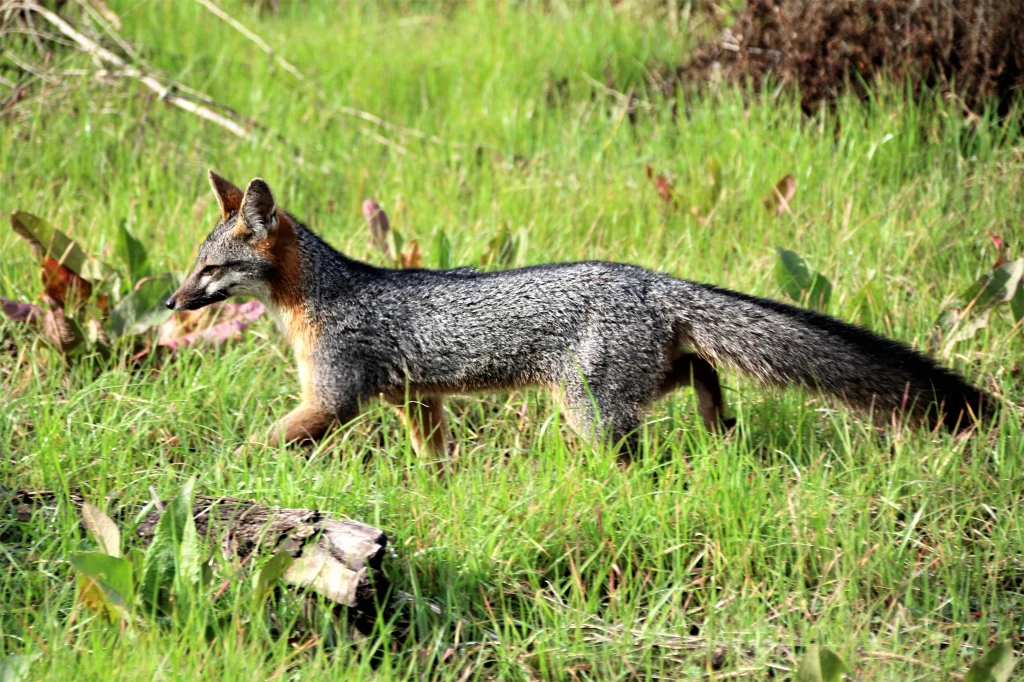A Non-Gray Fox Report
by William C. Leikam
President, CEO & Co-founder, Urban Wildlife Research Project
In all the time that I’ve been producing the monthly gray fox report, this month I have to miss sending it due to having to move to a new apartment and having come down with the flu. None-the-less, on Wednesday I fly to Montana and will be gone until July 15th. It’s my annual trip into the Badger-Two Medicine Wilderness. I can’t wait to get there, to be swallowed up in the depths of solitude.
In a nutshell, the foxes are out there doing just fine in raising their young. I have not picked up any trail camera shots of their young ones but will probably come upon them in late July. My two assistants – Jessica Hatfield and Sho-sho Ikeno – will be checking the trail cameras twice per day; once in the morning to collect the SD cards and once in the late afternoon to turn on the cameras for the night’s run.
Gray Foxes General Health
This pair is young, most likely first-year dispersals. They appear to be vibrant and healthy except for one common ailment. They both have intestinal worms, common at this time of year.
Total Numbers of Gray Foxes in the Palo Alto Baylands Nature Preserve
As of June 2019, we have two adult resident gray foxes and an unknown litter of pups occupying the Palo Alto Baylands Nature Preserve.
Section II
Update for the Urban Wildlife Research Project
-
Please donate so that we can begin the collaring project. Just go to our website, check out the letter and go to the donate button on the left of the page. Your donation is tax deductible. The collaring project needs $25,000 and here’s the reason why donate to uwrp?
We have no scheduled public presentations in the foreseeable future.
On May 24th, I was interviewed via live Internet video stream with the History Channel in New York City. I may be selected to appear in a documentary that they are producing. Keep the positive vibes flowing my way.
If you would like to see and hear the interview that Kevin Webb did with me, check out https://twitter.com/WebbKevin/status/1111294989429026816
You can still check out Punch Magazine – Article page 52, about Bill and the work he is doing at the Baylands including what’s next. Many have reported enjoying the article Keeping Vigil with the Fox Guy.
To find out more about us, search Urban Wildlife Research Project, UWRP, gray foxes, wildlife connection, linkages, corridors and several documentaries and clips on YouTube
- Check out our Facebook page.
- If you haven’t had a chance to read at least some of the articles that have been written about our study of gray fox behavior and our corridor work, click on these links as they will take you to the source: Bill Leikam – The Fox Guy, and Greg Kerekes & URWP
Section III
Gray Fox, Baylands Goals
Within the permit that allows the Urban Wildlife Research Project to conduct its study of the behavior of the gray fox at the Palo Alto Baylands Nature Preserve, the objectives covered area:
- Monitoring of urban gray fox Denning sites in Palo Alto Baylands.
This is being accomplished during the period when the gray foxes use a den site. It is one of the prime locations for gathering most of the behavioral data of the litter and for adults alike.
- Assessment of status and population trends of Baylands urban gray foxes
Since January 2019 a pair of resident gray foxes have claimed territory at the Palo Alto Baylands Nature Preserve.
- Identification of habitat features that promote the presence of urban gray foxes
After considering this and talking with people who know how to restore habitats, we need to assess what kinds of plants, including the Alkaline Salt Bush, would grow best along the edge of the saltwater channel and alongside the marsh. We need to grow a permanent habitat that contains the corridors and plant it as soon as possible. We’ll keep an eye on this as this is a critical link between the southern region of the Baylands and the northern region.
- Assessment of reproductive success and identification of factors that promote successful reproduction
Open up the pinch-point along Matadero Creek by developing thickets that link one area to another, instead of the present “islands”.
- Identification and assessment of possible dispersal travel routes.
Presently there can only be guesses as to dispersal travel routes. We intend to make this important question much more concrete when we attain our collaring/take/capture permit from the Department of Fish & Wildlife.




